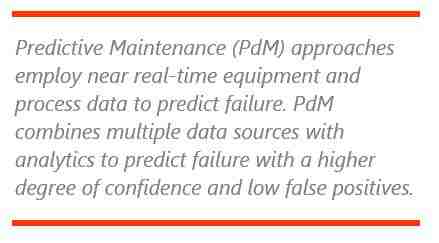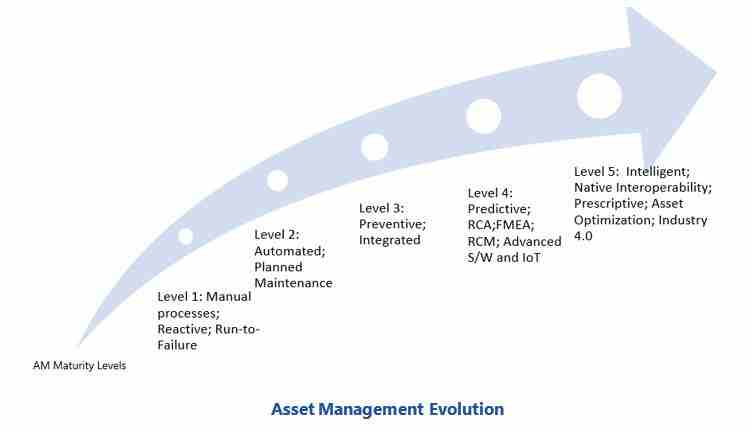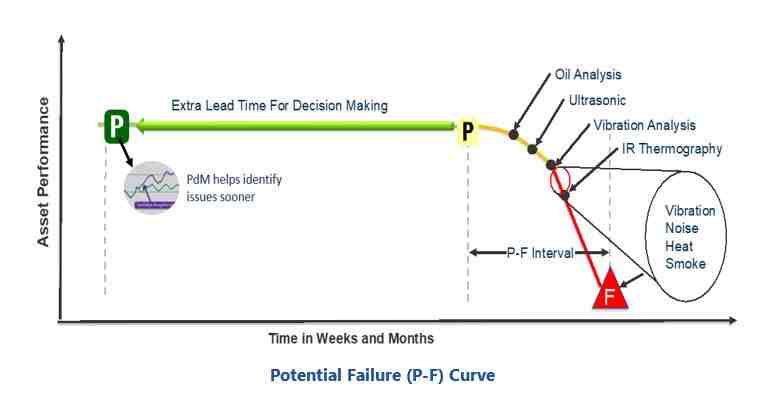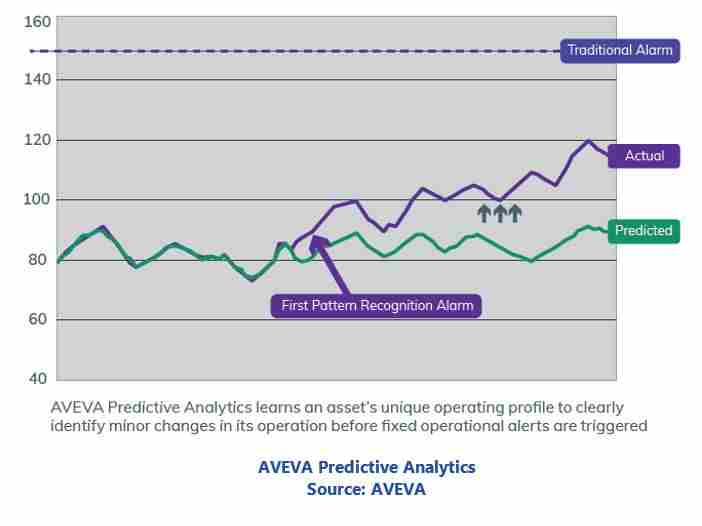

Organizations across all industries face tremendous pressure to increase shareholder value. In the industrial world, companies are striving to improve profitability, reduce costs, improve safety, and reduce unplanned downtime.  Advanced asset management strategies and technologies can help organizations meet all these objectives. Unfortunately, the traditional fix-it-when-it-breaks reactive approach to maintenance has been the major maintenance strategy for so long that the industrial world is struggling to move to the more effective proactive and predictive maintenance (PdM) approaches.
Advanced asset management strategies and technologies can help organizations meet all these objectives. Unfortunately, the traditional fix-it-when-it-breaks reactive approach to maintenance has been the major maintenance strategy for so long that the industrial world is struggling to move to the more effective proactive and predictive maintenance (PdM) approaches.
Preventive maintenance (PM) assumes a failure pattern that increases with age or use. Unfortunately, this applies to only 18 percent of assets. The other 82 percent of assets display a random failure pattern. In contrast, PdM approaches employ near real-time equipment and process data analysis to predict failure. PdM combines multiple data sources with analytics to predict failure with a higher degree of confidence and low false positives.
The industrial world has made tremendous improvements when it comes to maintenance strategies. A reactive maintenance strategy involves fixing equipment only when it is broken. While this is one of the oldest strategies, it is still appropriate for several non-critical assets in the plant.
Preventive maintenance (PM), sometimes also referred to as calendar-based maintenance, is the most utilized maintenance approach. In a recent ARC asset performance management (APM) survey, about half of the survey respondents stated using PM for most of their assets. When using this approach, most organizations follow the original equipment manufacturer’s (OEM) recommended service schedule. The second most popular maintenance approach, according to ARC’s research, is condition-based maintenance (CM). This approach involves monitoring the condition of assets, usually in real time, to determine when maintenance is needed.
With the advancements we have made in technology, organizations are now able to go further than condition-based maintenance. We can gather more data from our assets using sensors and leverage analytics to project wear and degradation of assets or its parts and predict asset failure in advance. A Prescriptive approach offers recommended actions and sometimes may trigger actions automatically.
All these different maintenance approaches have merits and make for an excellent choice in fitting situations. To leverage these approaches effectively, it is important that organizations develop a strategy based on the risk involved, the criticality of the assets/processes, as well as the ultimate goals of the organization.
Risk based Maintenance (RBM) and Reliability Centered Maintenance (RCM) have been two key methodologies when it comes to developing asset management strategies for the organization. RBM prioritizes maintenance resources based on the risk associated with the asset. Assets that have a greater risk and consequence of failure are maintained and monitored more frequently. RCM involves determining the most effective maintenance approach for assets. It usually includes planning to preserve system functions, identifying failure modes, addressing failure modes by criticality, and defining applicable maintenance tasks and selecting the most effective ones.

The RCM methodology employs reactive, PM, CM, and PdM techniques in an integrated manner to improve asset availability. Usually the asset-criticality analysis drives the maintenance strategy and approach. For some of the non-critical assets with no impact on plant’s key operations, a run-to-failure strategy is the best option.
On the potential failure (P-F) curve, the vertical (Y) axis represents some measure of asset performance or condition, and the horizontal (X) axis represents time-in-service for an asset, or asset component. The curve shows that the health of an asset or component declines over time, leading to functional failure, or loss of function, indicated by F on the curve. The yellow point, P, is the “potential failure point,” which occurs just before a condition exhibiting vibration, noise, heat, or smoke is detected.

Early detection of point P can be extremely helpful to organizations trying to minimize unplanned downtime. CBM practices, such as oil analysis, ultrasonic, vibration, and IR thermography, attempt to move the point P to the earliest time possible and maximize the P-F interval.
PdM takes asset monitoring to the next level, helping extend the P-F interval far to the left. By employing advanced modeling and machine learning (ML) technologies, PdM software solutions can now analyze hundreds of process parameters over time, as well as compare these to historical asset data. This can help to extend the P-F curve and hence improve lead times, providing operators with better information sooner so that they have more time to address the issues to avoid imminent asset failures.
As a leading industrial APM software supplier, AVEVA has decades of experience and deep domain knowledge to help its customers around the world with their asset management initiatives. The company’s AVEVA Predictive Analytics is a key solution helping users to improve asset performance and reduce unplanned downtime. The solution integrates with the customer’s existing PI systems and uses patented OPTiCS technology based on artificial intelligence (AI) and ML to provide early warning of potential asset failures and diagnosis of equipment health.
Many end users find it overwhelming to begin their PdM journey; wondering how to start and what kind of preparations to do to establish the program. As AVEVA Predictive Analytics offers native integration to the PI Server, it leverages existing machinery sensor data from the server to allow users to get started more easily with their PdM programs. Furthermore, data gaps are also a major concern for users. AVEVA Predictive Analytics addresses this issue by deploying KANN artificial neural network technology that helps to infer behavior when a complete training data set is lacking. The solution is equipment agnostic as well, meaning it can be used to monitor a wide variety of assets regardless of their type, vendor, or age.
Many industrial end users do not have in-house data scientists, and this has been a major hindrance for end users when it comes to establishing a successful PdM program. AVEVA addresses this challenge by offering an easy-to-use no-code solution that can be more easily used by reliability and maintenance personnel.
The solution also addresses another major challenge that we see in the industrial world today: the skills gap. The experienced boomer generation is leaving the workforce and fewer younger people are willing to join the industrial business, creating a widening skills gap in the industry. AVEVA Predictive Analytics facilitates knowledge capture and transfer by making maintenance decisions and processes repeatable. The solutions take asset management to the next level by offering prescriptive guidance, which is especially helpful to the younger workforce with limited years of experience. Along with alerts, prescriptive actions can also be included to guide the workforce to manage assets more quickly and effectively.
Another major roadblock to widespread adoption of PdM strategy has been industry’s siloed approach to PdM implementation. It has been treated as just an algorithm running on its own without integration with other business systems and strategies. This approach has yielded limited benefits to users. AVEVA’s solution-centric approach to PdM helps customers operationalize, scale, and sustain their predictive monitoring program. AVEVA Predictive Analytics with its built-in, ready-to-deploy features and ability to integrate with other business and asset management systems helps its customers succeed with their PdM initiatives. Its integration with other AVEVA software applications, such as AVEVA Asset Strategy Library, AVEVA Unified Operations Center, AVEVA APM Assessment, and many others, help its customers build a well-rounded and integrated APM strategy.
For SCG Chemicals, one of the largest petrochemical companies in Thailand, unplanned downtime was a major concern. To realize its vision of “zero unplanned downtime,” the company pursued a digital transformation initiative. The company was looking to build an advanced APM system to monitor critical assets and predict failures before they could lead to plantwide shutdowns.

The company partnered with AVEVA to develop a Digital Reliability Platform, a complete APM solution. Among other AVEVA solutions, the company implemented AVEVA Predictive Analytics to monitor the behavior of critical assets continuously in real time to detect machine abnormalities. The company also leveraged AVEVA Predictive Analytics’ rule-based engine to help determine the remaining useful life of the equipment. The company also utilized the solution’s prescriptive recommendations. According to SCG Chemicals, they were able to identify and resolve errors faster with AVEVA Predictive Analytics and hence increased plant operational efficiency. Leveraging various AVEVA solutions, the company was able to achieve nine times ROI within six months and virtually eliminate unplanned downtime. SCG Chemicals, with its successful digital initiative, is leading the way and setting a good example for other industry participants that are on a similar transformation journey.
For extremely critical assets, PdM offers numerous benefits. By providing an early warning, it helps users to address issues more quickly and effectively before they lead to significant issues and cause downtime. With its years of experience and deep domain knowledge, AVEVA is in an excellent position to help industrial organizations improve their asset management programs. AVEVA Predictive Analytics is not an ordinary modeling tool, thanks to its advanced features and capabilities that make it an easy to deploy, easy to use solution that users can operationalize and scale to their PdM programs.
ARC Advisory Group clients can view the complete report at ARC Client Portal
If you would like to buy this report or obtain information about how to become a client, please Contact Us
Keywords: Artificial Intelligence (AI), Machine Learning (ML), Predictive Maintenance, Digital Transformation, Condition Monitoring, Historian, Customer Success, ARC Advisory Group.

